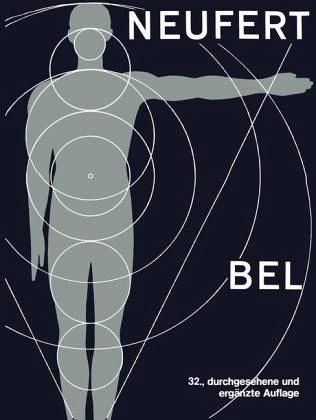


In addition to various other awards, Ernst Neufert received the Grand Cross of Merit of the Federal Republic of Germany in 1965.At the age of 17, after five years of working as a bricklayer, Neufert entered the school of construction (Baugewerbeschule) in Weimar. The most important practical works of the architect, who was primarily known for his industrial buildings, include the Abbeanum and the Student House in Jena (1929–1930), the Ledigenwohnheim apartment building on the Mathildenhöhe in Darmstadt (1952–1955), the main plant of the Eternit company in Leimen (1954–1960) and the Quelle mail-order firm in Nuremberg (1955–1958). It did not receive its practical addition – the Theory of Building Regulations – until its publication in 1943. In Germany alone, it has been published in 39 editions with numerous revisions. In addition, he continued his career as a freelance architect – including work as the resident architect for the Dyckerhoff-Portland cement factory – and as an author of specialist books.Īrchitects’ Data, first published in 1936, must be considered Neufert‘s most influential work. In 1945, Ernst Neufert was appointed as a professor for architecture at the Technical University of Darmstadt and taught until he became an emeritus professor in 1965. The majority of Neufert’s publications from that era were published by Speer. Starting in 1944, he was involved in planning reconstruction of the cities destroyed by the war. He was appointed as the commissioner for typing, standardisation and rationalisation of the Berlin residential construction. Starting in 1938, Neufert collaborated with Albert Speer – Hitler’s general building inspector for the Reich’s capital. That same year, he was readmitted and became the resident architect for the United Lusatia Glassworks – an office that he held until 1945. In 1936, he travelled to the USA in order to establish contact with Frank Lloyd Wright and explore the possibilities of a potential immigration and his opportunities on the American job market. The year of the takeover by the National Socialists was characterised by many visits to other countries for Neufert, which resulted in a variety of publications. He also simultaneously worked as a freelance architect until 1933. Neufert subsequently accepted a teaching position at the private Itten School in Berlin. In 1926, Otto Bartning summoned Neufert back to Weimar as the head of the building department and later as the assistant director at the State Technical University of Architecture and Civil Engineering. Significant projects such as the renovation of the Jena Stadttheater, the expansion of the Fagus factory in Alfeld an der Leine and the construction of the Bauhaus Building and the Masters’ Houses in Dessau took place during this period. From 1922 to 1925, Ernst Neufert was employed as a construction site manager for Walter Gropius. Among other events, he had a defining encounter with Antoni Gaudí and worked at the architecture office of Ricardo Magdalena. On leave for the summer semester of 1921, Neufert travelled with two other Bauhäuslers to study in Spain. From its start until the winter semester of 1920, he was also an employee at the private architecture office of Walter Gropius and Adolf Meyer. When the Bauhaus was opened in Weimar in 1919, Neufert enrolled as one of the first students. This was followed in 1918 by the exam at the School of Construction in Weimar and work for the Hannack & Ludwig company in Magdeburg. Construction manager in the private construction office GropiusĮrnst Neufert began an apprenticeship as a mason in 1914, which he completed with the apprenticeship certification exam.


 0 kommentar(er)
0 kommentar(er)
